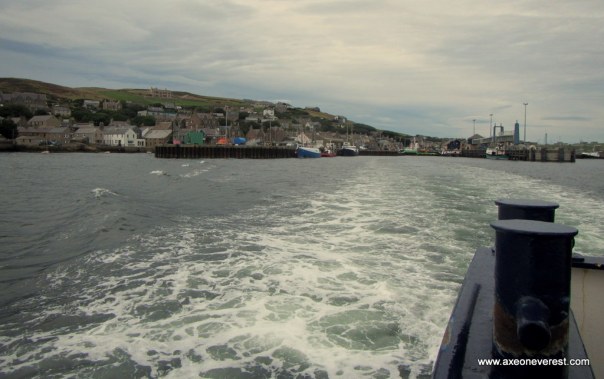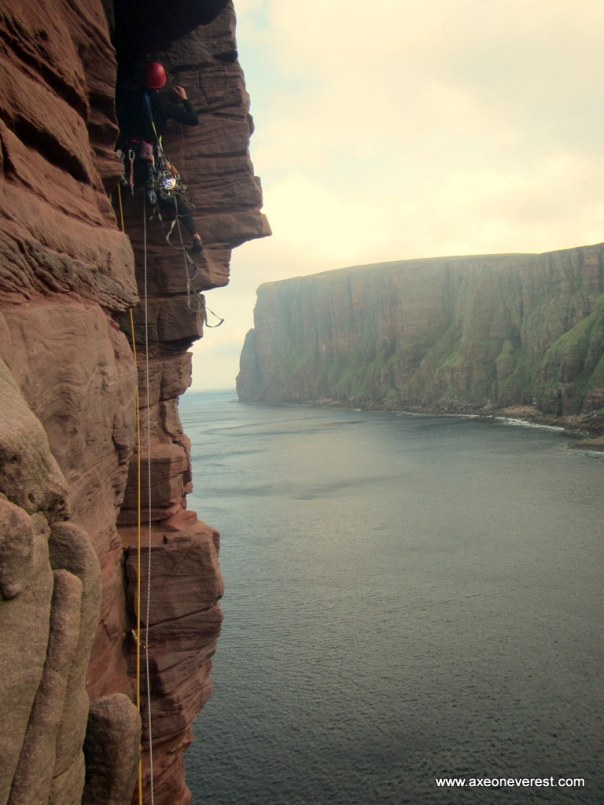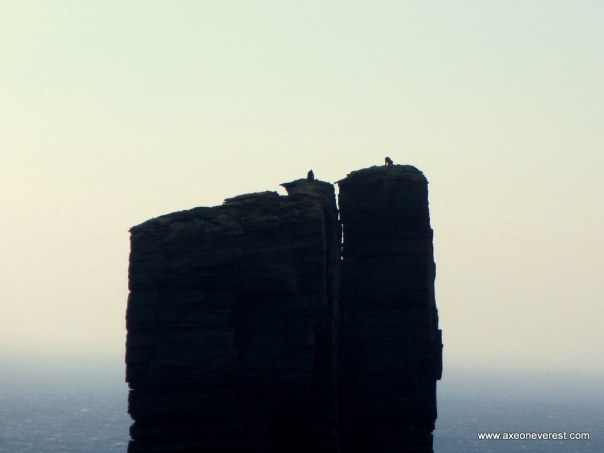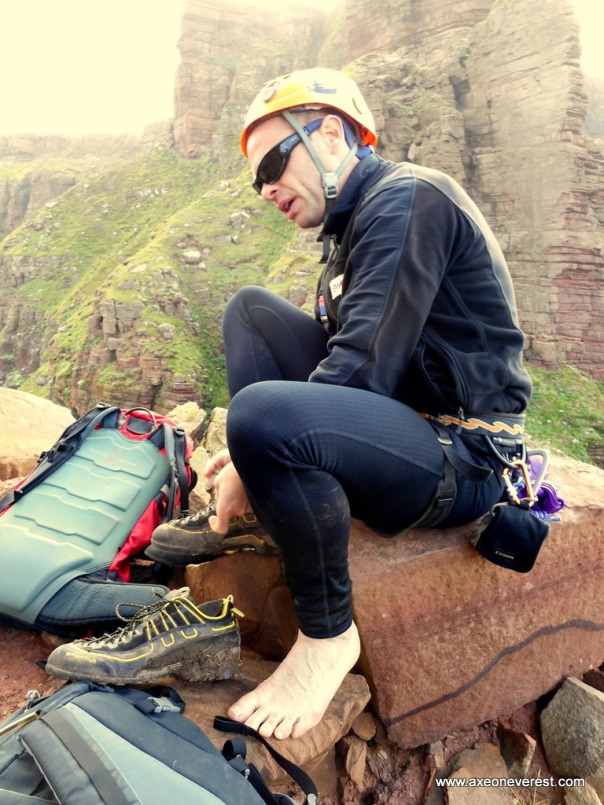The story of the old man who defeated two younger men
“That’s a very long way to go just to climb a rock” said my wife Stephanie over the phone as I gratefully flopped down in a seat on the ferry. “This is not just any old rock, this is the Old Man of Hoy – a 137m high ‘sea stack’ which is very famous” I replied to her in an attempt to justify my folly as I struggled to get my breath back. I was explaining to Stephanie the finer details of mine and trusty climbing partner Alan Silva’s plan to climb the Old Man of Hoy, located on Hoy Island in the Orkney Islands, Northern Scotland. So far the trip had involved flying from Singapore to Hamburg in Germany (for a business meeting), after which I flew on to London Gatwick, then took a connecting flight to Inverness in the north of Scotland. The next morning in a rental car with an engine smaller than most motor mowers, we drove 2.5 hours to Scrabster at the very northern tip of Scotland, arriving just 11 minutes before our ferry to the Orkney Islands departed. This saw us having to make a mad dash, running/stumbling the 1.2km from the car-park to the ferry boarding gates, our climbing packs bouncing heavily and uncomfortably on our backs.
After the phone call to Stephanie and my sweat had cooled and I regained my breath, I walked outside to the ferry sundeck. Very soon we had crossed the channel and the red-tinged sandstone seacliffs of Hoy appeared. I strained my eyes for the first glimpse of the Old Man, and sure enough there he appeared, looking a little bent at the top and cleverly camouflaged against the backdrop of the mainland behind him. From a long distance away on the ferry, it was hard to feel a scale for the size of the challenge that lay in wait for us, but all that would change the next morning.
The Old Man of Hoy is a 449-foot (137m) sea stack on the island of Hoy, part of the Orkney archipelago off the north coast of Scotland. Formed from Old Red Sandstone, it is one of the tallest stacks in Britain. The Old Man is very popular with climbers, and was first climbed in 1966. Created by the erosion of a cliff through hydraulic action some time after 1750, the stack is no more than a few hundred years old, and may soon collapse into the sea. (Source: Wikipedia). Alan had long harbored a desire to climb this incredibly unique piece of vertical geology, and I had agreed to join him on a quick three day jaunt to make an attempt.
We soon arrived in the small town of Stromness on the main Island of Orkney, departed the ferry and had a 3 hour wait for our second ferry ride of the day to the Island of Hoy. We sat at an outside table on the main street, drinking tea and watching the goings-on of the small community. Stromness is a sleepy and quaint town, mainly built of a light gray colored local stone. Some of the buildings date back back to the 16th/17th century when the town was first settled. Stromness is now the second largest town in the Orkney Islands group with a population of around 2000 people and a daily ferry service from mainland Scotland. The main industries are fishing, tourism, sheep farming and renewable energy. This was a day to be enjoyed by the tourists and we watched walkers and nature lovers wandering slowly up and down the main streets, enjoying the relaxed pace of life and the beautiful scenery.
At 6pm we boarded our second ferry ride for the day and steamed for 20 minutes south to land at Moaness on the Island of Hoy. Hoy Island has a much smaller population, around 400+ people, and is a windswept island, barren of trees with large, smooth, rounded hills rising to 400+m above sea-level. The scenery is stunning and beautiful, reminding me somewhat of southern Patagonia with its remoteness and constant wind.
We walked for one mile up a small hill to reach the Hoy Outdoor Centre, a wonderful hostel which could cater to probably 50 people or more. However this evening we shared it with only one other couple. The next morning we took a taxi (arranged by the hostel caretakers wife), for a journey of four miles to Rackwick Bay on the Western side of the Island. Rackwick bay is a stunning natural ampitheatre, a large bay with a pretty beach which forms into massive protective seacliffs at either end. Windswept and looking out directly to the Northern Atlantic Ocean, a small settlement once existed here, being home to artists, authors and bohemians. These days I was told, only one family is now based permanently here.
As we started walking we quickly noticed we were being greatly aided by a very strong tail wind which pushed us along in massive gusts. After 30 minutes we had reached the sea cliffs beside the Old Man and the wind had risen to such a strong level that we were very careful to stay away from the edges, in fair of being blown over. The first view of the Old Man was intimidating. I had studied numerous photos and video of our route and could trace it out with my eyes, however the share size and exposure of the climb once up close was a shock. The strength of the wind also was not aiding my confidence level and as I gazed over to the summit, a small grass patch no larger than a small bathroom area. I tried to imagine what it would be like standing there with these massive gusts of wind.

Alan Silva standing on the sea cliffs in strong winds – the summit of the Old Man of Hoy seen behind him.
The track leading down to the Old Man is exposed and requires care in many places. We slowly picked our way down, happy to be in the shelter of the cliffs which blocked the winds for the 15 minutes it took to arrive at the base. Once at the bottom we were once again exposed to the wind and we both stood at the base surveying the massive stone structure in front of us.
“What do you think of this wind Al?” I yelled in between gusts. “Not that much Grant, its not nice trying to climb in wind like this, the ropes get blown sideways” replied Alan. “Yeah, it would also be pretty dodgy at the higher up where the wind will be stronger” I added, so we soon found some shelter and sat and decided to wait for sometime to see if it would abate. What a magnificent spot to wait. We watched seals swimming around the coastline below us, the ferry to Stromness passed by us far out to sea, we saw fulmars (sea-birds) nesting on the ledges on the Old Man of Hoy and could even make out old pitons and slings from much earlier climbs hanging from the rock.
Two hours and two ham sandwiches later the wind had not abated and we were trying to decide what to do when two young German climbers arrived at the base. “The forecast is for the wind to get stronger today so we are going now” they explained to us. And with that they had set-up their ropes and were off. This spurred us into action also and as soon as they had cleared the first pitch Alan lead off. The route we were attempting is the original route – the way it was first climbed in 1966 by Chris Bonington and Tom Patey. The original climbers returned in 1967 and climbed it again, this time whilst being filmed by the BBC which made the documentary attached below and played it on Christmas day 1967 to over 15 million people I believe. This in effect made the Old Man of Hoy into a national celebrity in the UK.
The original route consists of four pitches of climbing, with the first being the easiest, and the second being the most difficult. We knew if we could get over the second pitch we would be able to make the summit. When I arrived at the belay ledge at the top of the first pitch we had a long wait while the German team climbed the second pitch. We were wondering what was taking so long and were soon to find out why.
The second pitch is awkward for a number of reasons. From the belay spot, the climber must first down climb to a narrow ledge, then cross this then climb a vertical crack passing two overhanging roofs. The climbing on the second pitch is really hard and exposed. It is rated at grade 20 in the NZ climbing grade, and even though I had been training hard for this climb, three times a week in our local crag in Singapore, this was harder than the level I could climb at. I was however happy enough to second it behind Alan. Alan, a much more experienced rock climber than myself was climbing grade 20 in Singapore, so was tasked with leading this crux pitch.
From the belay ledge at the top of the 1st pitch, the lead climber soon disappears from site as they start off on the second pitch. With the strong wind, communication was virtually impossible, unless the timing was perfect enough to wait for temporary lull or break in the winds which came along very sporadically. After what seemed like a very long time, the German leader reached the belay at the second pitch and his partner moved up to join him. Now it was Alan’s turn. He set-off on the traverse, as I carefully belayed him. He was soon across the awkward ledge and ready to take on the vertical crack. After 3m of vertical climbing he clipped into a rusty old piton, then disappeared from my site as he climbed higher. My only contact with him was the rope between my fingers as I felt it play out as he climbed higher. The rope moved slower and slower until it stopped moving at all. “Must be hard” I thought to myself as I imagined his struggle on the rock face.
For the next 20 minutes I stood and waited, the ropes moving a tiny bit forward but then dropping back again. “Must be really hard” I thought again to myself. As with any situation where you have to stand and wait with little knowledge what is happening, your mind starts to play all sorts of tricks as you imagine the scenario. Then I heard Alan’s voice shout “I am almost at the ledge”.
Great news! But as I broke into a smile I felt a jerk on the ropes, as if he had fallen. We were using double ropes to climb (two ropes) which were creating a lot of drag for Alan, especially with the awkward traverse meaning they were not running straight, but in a zigzag fashion. Thus I could not feel his movements immediately through the rope. “That was strange” I said to myself, not overly concerned as I was sure Alan had shouted to me that he was at the belay ledge. However another 10 minutes later there was still no movement. Finally I managed to catch Alan’s voice once again, “Slack!”. As I gave out slack on the rope he dropped back down into view looking pale and exhausted. “I can’t do it Grant, I am at the crux and its too hard. I tried three times and fell once, I don’t have enough strength left”. “But I thought I heard you yell you were at the ledge?” I responded in surprise. “No I yelled out I was falling!”. In the strong winds somehow I had misheard him completely.
Alan was knackered and if he could not climb this pitch there was no way I could climb it. So we we dejectedly abseiled back to the base of the climb, packed our gear and began the walk-out. As we made our way back up the path to the cliff tops it was great to see the two German climbers reach the summit and I shot these photos of them. However I felt very much for Alan as I knew how much it meant to him to climb the Old Man. We discussed our options as we walked out in the strong winds. “Well we still have a few hours tomorrow to make another attempt Al?”. “That’s it Grant, lets come back tomorrow and have another crack, I will get my aid gear set-up and can try aiding the crux (most difficult section) if I need to”. With that his mood changed instantly and he strode off with a much more positive manner.
The next morning we once again returned to the base of the Old Man. This time I lead the first pitch, and very soon reached the belay and bought Alan up to join me. Overnight the crack system had become quite wet however, and as Alan began the delicate traverse he immediately struggled with the wet, soft, standstone. In parts he explained it was actually muddy and very sandy with many downwards sloping holds making the climbing very difficult. As there are no bolts on this climb, he was carrying a large amount of weight with all the metal climbing gear he was using to insert into the cracks to protect his fall. This weight, the wet, soft, muddy, sandstone coupled with the rope drag of the two 9mm ropes made it very hard work and once again the pitch defeated us. Around 11AM we retreated, abseiling from the second pitch, agian disappointed with not making the summit but secure in the knowledge we had given it our best attempt.
As a consolation we opted to forgo the taxi, and make the 3 mile walk back to Moaness. This turned out to be a beautiful walk, and quite therapeutic, through the peat, heather and mountain tarns (lakes). We returned to Stromness on the evening ferry and took the following morning 6AM ferry back to mainland Scotland. As we sailed past the Old Man on the way home, I walked out onto the back deck of the ferry. It was very misty and I was alone. I could just make out his summit through the cloud and I had a special moment where once again, I thanked climbing for taking me on this remarkable journey to an amazing part of the world, that I otherwise may never have known existed or had the motivation to visit. Summit or no summit, the journey itself had been spectacular and I had no regrets. I hope the Old Man of Hoy will be there for many more years to come, and I hope the next time I visit, the Old Man will be kinder and allow us to stand on top.
Posted on August 30, 2015, in rock climbing and tagged climb old man of hoy, old man of hoy. Bookmark the permalink. 9 Comments.














What’s next please? Sorry the wind defeated you but fancy letting two guys beat you. Anyway at least you lived to fight another day and so enabling you to take me on another trip
“Someday, somewhere ” 😥
LikeLike
That’s the first time you guys haven’t accomplished your goal! It must have been hard for Al to give in, I have known him for 25 years and have never heard those words pass his lips! As you said Axe, the journey was worth the defeat. There will be another time I am certain. My hope is that you didn’t mention the war to the Crouts! Congrats on the effort. Ada
LikeLike
Hi Ada, yep was a tough pitch for Mr Al alright! No mention of the war either 🙂
LikeLike
Kudos to you both on valiant attempts and pushing against adversity. Great prose to share a spectacular trip. But not a mention of even a dram of scotch? Cheers mate and cracking effort.
LikeLike
Thanks mate. The closest pub was 16 miles away, so we would have to be very motivated to have a tipple!
LikeLike
Awesome effort Axe! Truly hope you get another shot at the old man.
Would love to go climbing with you in Singapore some time soon.
All the best to you and Stephanie.
LikeLiked by 1 person
For sure Tom, would love to climb with you, lets book a date!
LikeLike
Great article Grant. It takes courage to write about failed attempts but you can learn just as much from them, and come back stronger the next time. You know that of course from Everest. And thanks for linking the original BBC footage – wow does that look dated! I have to confess being old enough to remember watching it live on TV when I was a lad…! Anyway well done you guys for giving it your best in far from ideal conditions. You’ll do it next time, no sweat!
LikeLike
Cheers Rob, you have an amazing memory to recall the first ascent being shown! We are looking forward to the ‘next time’ – maybe you should join us!
LikeLike